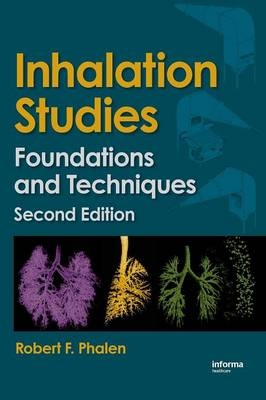
Inhalation Studies
Crc Press Inc (Verlag)
978-0-8493-1400-1 (ISBN)
The Second Edition was motivated by:
new developments in the ultrafine particle health effects and concentrated aerosol research
advances in understanding postnatal lung growth and the deposition and clearance of inhaled particles
new techniques in toxicity testing
the explosion of knowledge in the genetic and molecular realms
the introduction of a large number of transgenic animal models
updated ethical guidelines for animal testing
the emergence of aerosol medicine
the growing threat of aerosol-related terrorism
increased appreciation of nonpulmonary effects of inhaled substances
use of medical scanning techniques to study respiratory tract structure
the introduction of new inhalation exposure systems
the emergence of aerosol concentrators for use in air pollution studies
ROBERT PHALEN Ph.D., co-directs the Air Pollution Health Effects Laboratory at the University of California, Irvine (UCI). He also holds two academic appointments in the College of Health Sciences at UCI: Professor in the Department of Community and Environmental Medicine; and Professor in the Department of Medicine’s Center for Occupational and Environmental Health. He has served as Chair of both the UCI Institutional Review Board (for Human Studies) and the Institutional Animal Care and Use Committee. He is currently a member of the United States Environmental Protection Agency’s Clean Air Scientific Advisory Committee—Particulate Material, and he is a member of 11 professional scientific associations/societies. In 1971, he obtained a Ph.D. in biophysics, with specialization in inhalation toxicology, from the University of Rochester (in Rochester, NY). His postdoctoral research was conducted at the Inhalation Toxicology Research Institute (now the Lovelace Respiratory Research Institute) in Albuquerque, NM. In 1972, Dr. Phalen joined the then College of Medicine at UCI to establish the Air Pollution Health Effects Laboratory, which still conducts studies relating to the toxicology of air pollutants, and trains graduate students and physicians in inhalation toxicology. His research is in several areas including: predicting doses from inhaled particles; health effects of inhaled air pollutants; and applied aerosol physics. He has published over 100 scientific papers, and authored and/or edited four previous books on aerosol inhalation topics.
1. Aerosols and Gases. Introduction. Direct Observation of Aerosol Particles. Cigarette Smoke: A Familiar Aerosol System. Particle Size. Size Distributions. Aerosol Properties. Aerosol Dynamics. Particle Size and Toxicity. Properties of Gases. 2.The Respiratory Tract. Introduction. Postnatal Development. Compartments. Gross Anatomy. Cells and Tissues. Ventilation. Deposition of Inhaled Particles. Uptake of Inhaled Gases. Defenses. 3. Establishing and Controlling Exposures. Introduction. Cleaning and Conditioning. Throughput Air. Aerosol Generation. Gas Generation. Mixed Aerosols and Gases. Principles for Stabilizing the Exposure Atmosphere. 4. Characterizing Exposures. Introduction. The Breathing Zone. What should be Measured? Instrumentation. Eliminating Measurement Interferences. Sampling Protocols. 5. Methods for Exposing Subjects. Introduction. Basic Types of Exposure Systems. Aging the Atmosphere. Ammonia as a Contaminant. Determination of the Inhaled Dose. Ethical Responsibilities of the Investigators. 6 Testing for Toxicity. Introduction. Qantitation. Anatomical Considerations. Morphometry. Pulmonary Function. Other Endpoints. Controls. Batteries of Endpoints. 7. Experimental Designs. Introduction. Basic Statistical Considerations. Examples of Common Designs. Multicomponent Atmospheres. 8. Facilities and Support Considerations. Introduction. Facilities Components. Facilities Location. 9. Animal Models. Introduction. Extrapolation from Laboratory Animals to Humans. Comparative Dose Distribution. Comparative Physiology and Anatomy. Common Laboratory Animal Models. 10. Regulations and Guidelines. Introduction. Guidelines vs. Regulations. Protection of Laboratory Personnel. Protection of Research Subjects. Inhalation Toxicity Testing Guidelines.
| Erscheint lt. Verlag | 22.10.2008 |
|---|---|
| Zusatzinfo | 65 Tables, black and white; 23 Halftones, black and white; 73 Illustrations, black and white |
| Verlagsort | Bosa Roca |
| Sprache | englisch |
| Maße | 178 x 254 mm |
| Gewicht | 657 g |
| Themenwelt | Studium ► 1. Studienabschnitt (Vorklinik) ► Physiologie |
| ISBN-10 | 0-8493-1400-3 / 0849314003 |
| ISBN-13 | 978-0-8493-1400-1 / 9780849314001 |
| Zustand | Neuware |
| Haben Sie eine Frage zum Produkt? |
aus dem Bereich


